
目录
一. 为什么学习string?二、 标准库中的string2.1 string介绍2.2 string的常用接口说明2.2.1 string对象的常见构造2.2.1.1 [string()](https://legacy.cplusplus.com/reference/string/string/string/) ---- 无参构造函数2.2.1.2 [string(const char* s)](https://legacy.cplusplus.com/reference/string/string/string/) ---- 有参构造函数2.2.1.3 [string(size_t n, char c)](https://legacy.cplusplus.com/reference/string/string/string/) ---- 有参构造函数2.2.1.4 [string(const string&s)](https://legacy.cplusplus.com/reference/string/string/string/) ---- 拷贝构造函数 2.2.2 string对象的容量操作2.2.2.1 [size 函数](https://legacy.cplusplus.com/reference/string/string/size/)2.2.2.2 [length 函数](https://legacy.cplusplus.com/reference/string/string/length/)2.2.2.3 [capacity 函数](https://legacy.cplusplus.com/reference/string/string/capacity/)2.2.2.4[ empty 函数](https://legacy.cplusplus.com/reference/string/string/empty/)2.2.2.5 [clear 函数](https://legacy.cplusplus.com/reference/string/string/clear/)2.2.2.6 [reserve 函数](https://legacy.cplusplus.com/reference/string/string/reserve/)2.2.2.7 [resize 函数](https://legacy.cplusplus.com/reference/string/string/resize/) 2.2.3 string对象的访问及遍历操作2.2.3.1 [operator[]](https://legacy.cplusplus.com/reference/string/string/operator%5B%5D/)2.2.3.2 迭代器 [begin ](https://legacy.cplusplus.com/reference/string/string/begin/)、[end](https://legacy.cplusplus.com/reference/string/string/end/)2.2.3.3 迭代器 [rbegin](https://legacy.cplusplus.com/reference/string/string/rbegin/) 、[rend](https://legacy.cplusplus.com/reference/string/string/rend/)2.2.3.4 范围for 2.2.4. string对象的增删查改2.2.4.1 [push_back 函数](https://legacy.cplusplus.com/reference/string/string/push_back/)2.2.4.2 [operator+=](https://legacy.cplusplus.com/reference/string/string/operator+=/)2.2.4.3 [append 函数](https://legacy.cplusplus.com/reference/string/string/append/)2.2.4.4 [insert 函数](https://legacy.cplusplus.com/reference/string/string/insert/)2.2.4.5 [erase 函数](https://legacy.cplusplus.com/reference/string/string/erase/)2.2.4.6 [npos](https://legacy.cplusplus.com/reference/string/string/npos/)2.2.4.7 [c_str 函数](https://legacy.cplusplus.com/reference/string/string/c_str/)2.2.4.8 [find 函数](https://legacy.cplusplus.com/reference/string/string/find/)2.2.4.9 [rfind 函数](https://legacy.cplusplus.com/reference/string/string/rfind/)2.2.4.10 [substr 函数](https://legacy.cplusplus.com/reference/string/string/substr/) 三、string拷贝问题3.1 经典的string问题3.2 浅拷贝3.3 深拷贝3.4 写时拷贝 四、string的模拟实现4.1 string默认成员函数的实现4.2 string 中 c_str 、size 、capacity 和 empty 的实现4.3 string 中 resize 和 reverse 的实现4.4 string 中 push_back 、append 和 operator+= 的实现4.5 string 中 operator[] 的实现4.6 string 中 迭代器 的实现4.7 string 中 operator<< 和 operator>> 的实现4.8 string 中 比较函数 的实现4.9 string 中 find 的实现4.10 string 中 insert 和 erase 的实现4.11 string 中 substr 的实现4.12 string 实现汇总及函数测试 结尾
一. 为什么学习string?
C语言中,字符串是以’\0’结尾的一些字符的集合,为了操作方便,C标准库中提供了一些str系列的库函数,但是这些库函数与字符串是分离开的,不太符合OOP的思想,而且底层空间需要用户自己管理,稍不留神可能还会越界访问。
二、 标准库中的string
2.1 string介绍
string的文档介绍
字符串是表示字符序列的类。标准的字符串类提供了对此类对象的支持,其接口类似于标准字符容器的接口,但添加了专门用于操作单字节字符字符串的设计特性。string是使用char(即作为它的字符类型,使用它的默认char_traits和分配器类型(关于模板的更多信息,请参阅basic_string)。string类是basic_string模板类的一个实例,它使用char来实例化basic_string模板类,并用char_traits和allocator作为basic_string的默认参数(根于更多的模板信息请参考basic_string)。注意,这个类独立于所使用的编码来处理字节:如果用来处理多字节或变长字符(如UTF-8)的序列,这个类的所有成员(如长度或大小)以及它的迭代器,将仍然按照字节(而不是实际编码的字符)来操作。 总结:
string是表示字符串的字符串类该类的接口与常规容器的接口基本相同,再添加了一些专门用来操作string的常规操作。string在底层实际是:basic_string模板类的别名,typedef basic_string<char, char_traits, allocator>string;不能操作多字节或者变长字符的序列。 在使用string时,必须包含#include头文件以及using namespace std;
2.2 string的常用接口说明
2.2.1 string对象的常见构造
2.2.1.1 string() ---- 无参构造函数
构造空的string对象,即空字符串#include <iostream>#include <string>using namespace std;int main(){string s;cout << s <<endl;return 0;}
2.2.1.2 string(const char* s) ---- 有参构造函数
用C-string来构造string对象#include <iostream>#include <string>using namespace std;int main(){string s("chineseprson");cout << s << endl;return 0;}
2.2.1.3 string(size_t n, char c) ---- 有参构造函数
string对象中包含n个字符c#include <iostream>#include <string>using namespace std;int main(){string s(10,'z');cout << s << endl;return 0;}
2.2.1.4 string(const string&s) ---- 拷贝构造函数
拷贝构造函数#include <iostream>#include <string>using namespace std;int main(){string s("chineseprson");string ss(s);cout << s << endl;cout << ss << endl;return 0;}
2.2.2 string对象的容量操作
2.2.2.1 size 函数
返回字符串有效字符长度#include <iostream>#include <string>using namespace std;int main(){string s("chineseprson");cout << s.size() << endl;return 0;}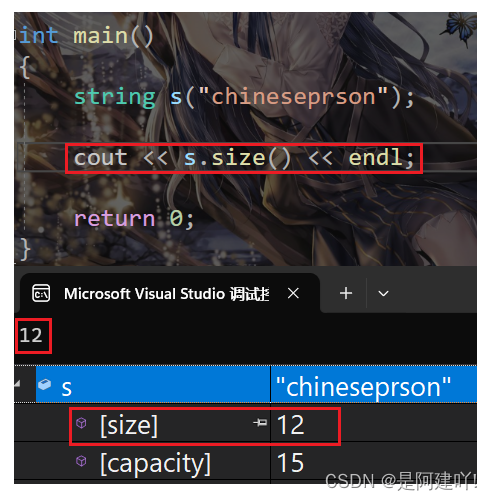
2.2.2.2 length 函数
返回字符串有效字符长度size() 与 length() 方法底层实现原理完全相同,引入 size() 的原因是为了与其他容器的接口保持一致,一般情况下基本都是用 size()。#include <iostream>#include <string>using namespace std;int main(){string s("chineseprson");cout << s.length() << endl;return 0;}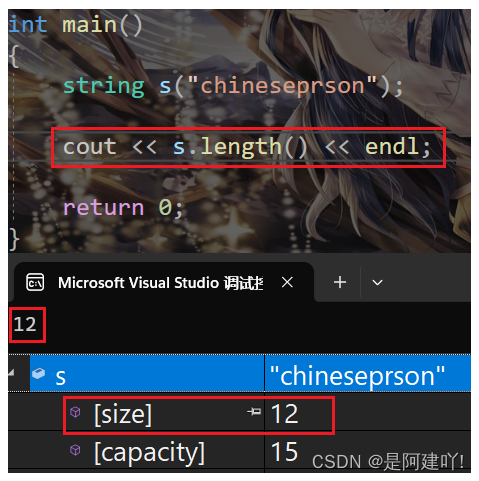
2.2.2.3 capacity 函数
返回空间总大小#include <iostream>#include <string>using namespace std;int main(){string s("chineseprson");cout << s.capacity() << endl;return 0;}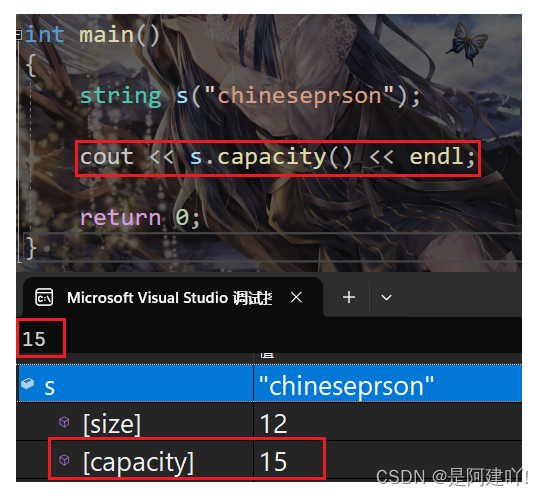
2.2.2.4 empty 函数
检测字符串释放为空串,是返回true,否则返回false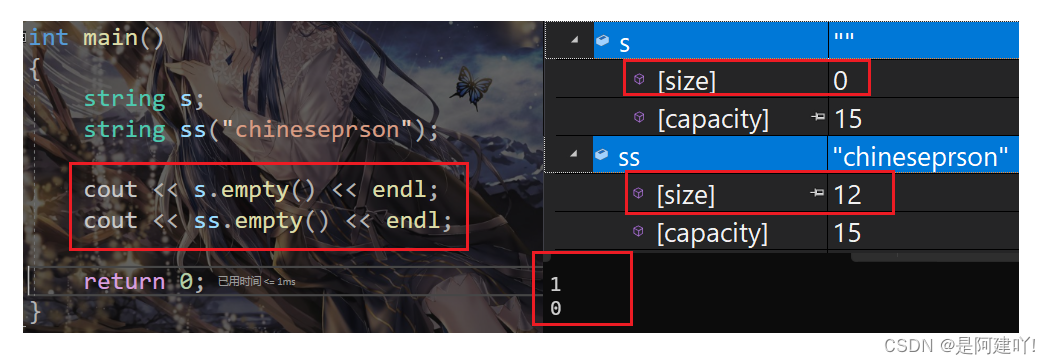
#include <iostream>#include <string>using namespace std;int main(){string s;string ss("chineseprson");cout << s.empty() << endl;cout << ss.empty() << endl;return 0;}2.2.2.5 clear 函数
清空有效字符clear()只是将string中有效字符清空,不改变底层空间大小。#include <iostream>#include <string>using namespace std;int main(){string s("chineseprson");cout << s << endl;s.clear();cout << s << endl;return 0;}
2.2.2.6 reserve 函数
为字符串预留空间reserve(size_t res_arg=0):为string预留空间,不改变有效元素个数,当reserve的参数小于string的底层空间总大小时,reserver不会改变容量小。#include <iostream>#include <string>using namespace std;int main(){string s("chineseprson");s.reserve(30);cout << s << endl;return 0;}
2.2.2.7 resize 函数
resize(size_t n) 与 resize(size_t n, char c)都是将字符串中有效字符个数改变到n个,不同的是当字符个数增多时:resize(n)用 '\0' 来填充多出的元素空间,resize(size_t n, char c)用字符c来填充多出的元素空间。注意:resize在改变元素个数时,如果是将元素个数增多,可能会改变底层容量的大小,如果是将元素个数减少,底层空间总大小不变。#include <iostream>#include <string>using namespace std;int main(){string s("chineseprson");cout << s << endl;s.resize(30,'6');cout << s << endl;return 0;}
2.2.3 string对象的访问及遍历操作
2.2.3.1 operator[]
返回pos位置的字符,const string对象调用#include <iostream>#include <string>using namespace std;int main(){string s("chineseprson");for (int i = 0; i < s.size(); i++){printf("[%d] : %c\n", i, s[i]);}cout << endl;return 0;}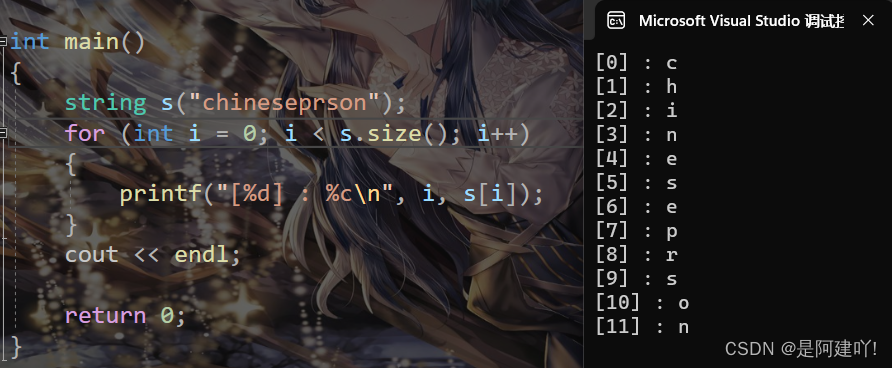
2.2.3.2 迭代器 begin 、end
begin 获取第一个字符的迭代器 end 获取最后一个字符下一个位置的迭代器#include <iostream>#include <string>using namespace std;int main(){string s("chineseprson");string::iterator it = s.begin();while (it != s.end()){cout << *it << ' ';it++;}cout << endl;return 0;}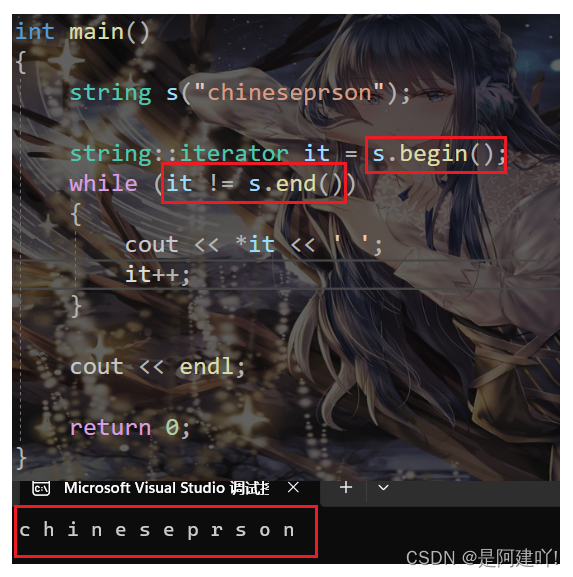
2.2.3.3 迭代器 rbegin 、rend
rbegin 获取最后一个字符的迭代器 rend 获取第一个字符前一个位置的迭代器#include <iostream>#include <string>using namespace std;int main(){string s("chineseprson");string::reverse_iterator it = s.rbegin();while (it != s.rend()){cout << *it << ' ';it++;}cout << endl;return 0;}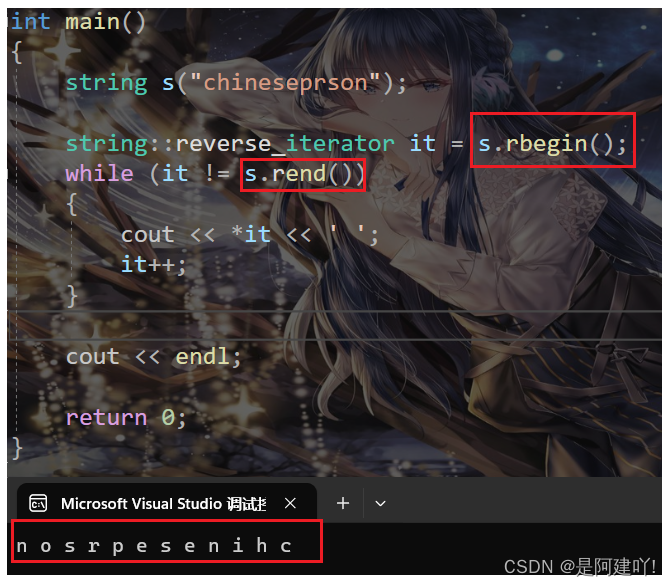
2.2.3.4 范围for
范围for作为C++新出的遍历方法,相对于以前的遍历方式它能够更加简洁的遍历数组、容器等数据结构中的元素。
#include <iostream>#include <string>using namespace std;int main(){string s("chineseprson");for (auto ch : s){cout << ch << ' ';}cout << endl;return 0;}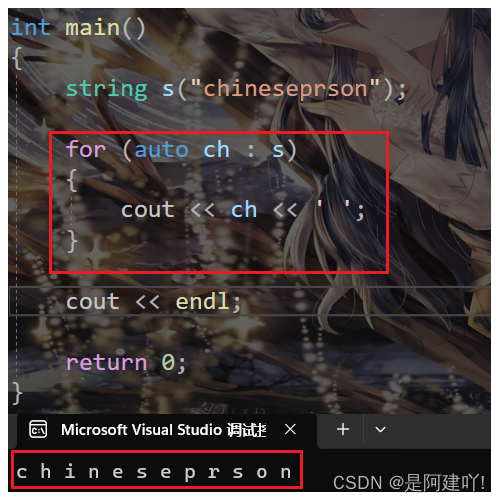
2.2.4. string对象的增删查改
2.2.4.1 push_back 函数
在字符串后面加一个字符#include <iostream>#include <string>using namespace std;int main(){string s("chineseprson");s.push_back('6');cout << s << endl;s.push_back('6');cout << s << endl;s.push_back('6');cout << s << endl;return 0;}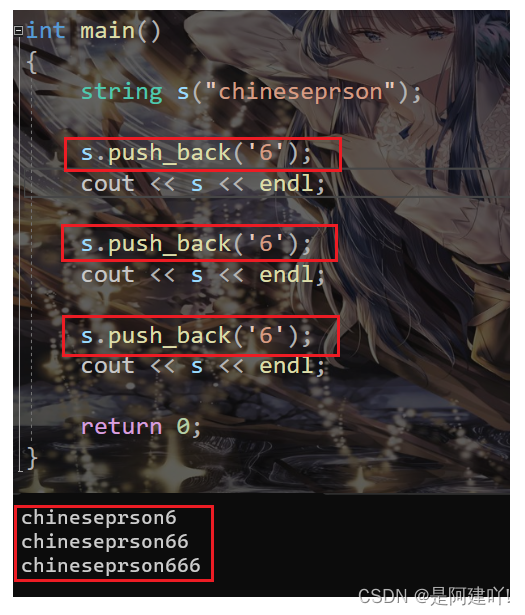
2.2.4.2 operator+=
string& operator+= (const string& str);operator+= 能够在字符串最后追加一个string对象内的字符串string& operator+= (const char* s);string& operator+= (char c);operator+= 能够在字符串后面加一个字符或者字符串#include <iostream>#include <string>using namespace std;int main(){string s("chineseprson");s += '6';cout << s << endl;s += "666666";cout << s << endl;string ss("牛牛牛");s += ss;cout << s << endl;return 0;}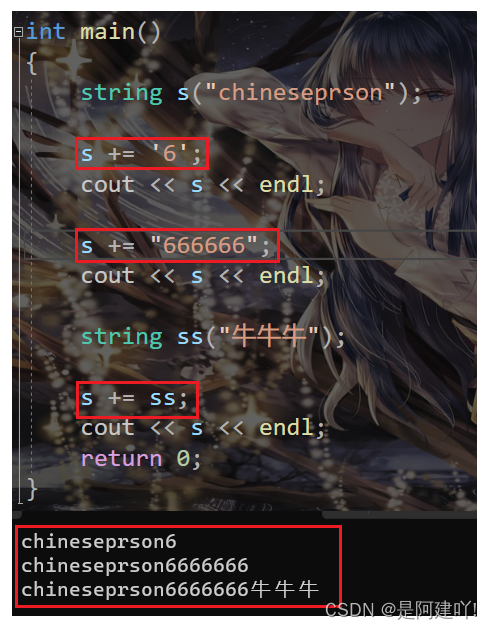
2.2.4.3 append 函数
string& append (const string& str);append 函数能够在字符串最后追加一个string对象内的字符串string& append (const string& str, size_t subpos, size_t sublen);append 函数能够在字符串最后追加一个string对象内的字符串的一段字符串string& append (const char* s);append 函数能够在字符串最后追加一个string对象内的字符串string& append (const char* s, size_t n);append 函数还能够在字符串后面追加字符串的前 n 个string& append (size_t n, char c);append 函数能够在字符串后面追加 n 个字符注意:append 函数与 operator+= 作用有部分相同
若是单纯在字符串后面追加一个字符或者字符串,更习惯使用 operator+=
#include <iostream>#include <string>using namespace std;int main(){string s("chineseprson");// 追加n个字符s.append(1,'6');cout << s << endl;// 追加一个字符串s.append("666666");cout << s << endl;// 追加一个字符串的前n个s.append("888888888", 3);cout << s << endl;return 0;}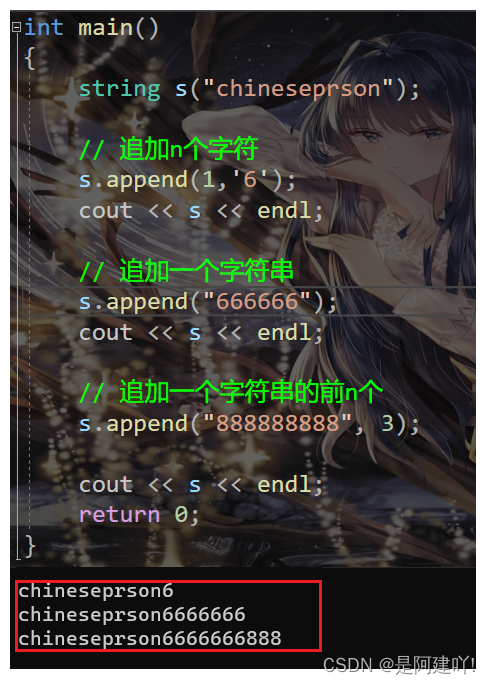
2.2.4.4 insert 函数
string& insert (size_t pos, const string& str);insert函数能够在字符串任意位置插入一个string容器内的字符串string& insert (size_t pos, const string& str, size_t subpos, size_t sublen);insert函数能够在字符串任意位置插入一个string对象内的字符串的一段字符串string& insert (size_t pos, const char* s);insert函数能够在字符串一段字符串string& insert (size_t pos, const char* s, size_t n);insert 函数还能够在字符串任意位置插入字符串的前 n 个string& insert (size_t pos, size_t n, char c);insert 函数还能够在字符串任意位置插入n个字符#include <iostream>#include <string>using namespace std;int main(){string s("student");string ss("test");// 在第三个位置插入strings.insert(1, ss);cout << s << endl;// 在最后插入string的一部分s.insert(s.size(), ss , 0 , 2);cout << s << endl;// 在第一个位置插入strings.insert(0,"666");cout << s << endl;// 其他插入方法一样,这里省略return 0;}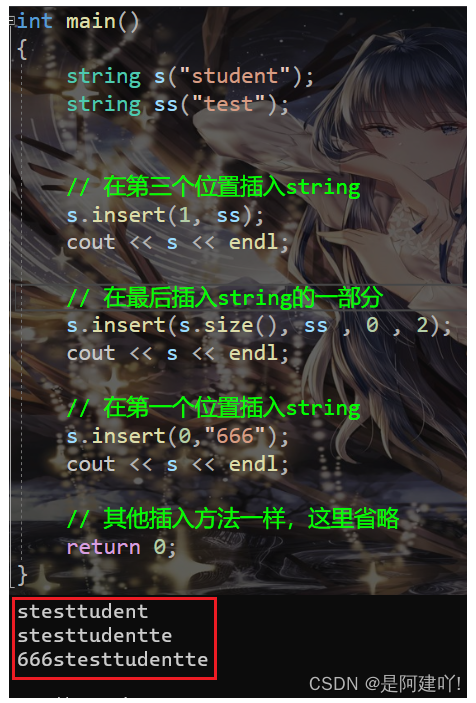
2.2.4.5 erase 函数
string& erase (size_t pos = 0, size_t len = npos);erase 函数能够删除第 n 个位置后面长度为 len 的字符串如果没有传 len 或是 第 n 个位置后面的字符数小于 len ,则n后面的字符全部删除#include <iostream>#include <string>using namespace std;int main(){string s("student");s.erase(4, 2);cout << s << endl;s.erase(1);cout << s << endl;return 0;}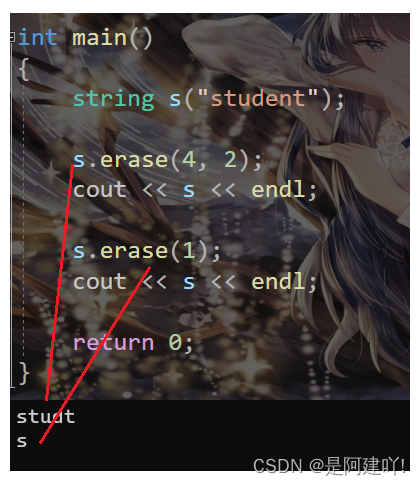
2.2.4.6 npos
npos的值通常是一个很大的正数,等于-1(当作为无符号数解释时)或等于string::size_type的最大可能值。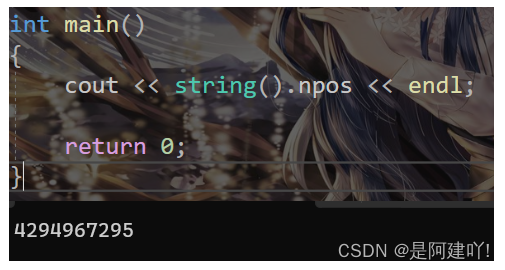
2.2.4.7 c_str 函数
返回C格式字符串在C++中,printf 是一个C语言函数,它不支持直接打印std::string类型的内容。这是因为 printf 是一个可变参数函数,而 std::string 不是基本数据类型,因此需要转换为C风格字符串才能由 printf 输出。
#include <iostream>#include <string>using namespace std;int main(){string s("chineseprson");printf("%s\n", s);printf("%s\n", s.c_str());return 0;}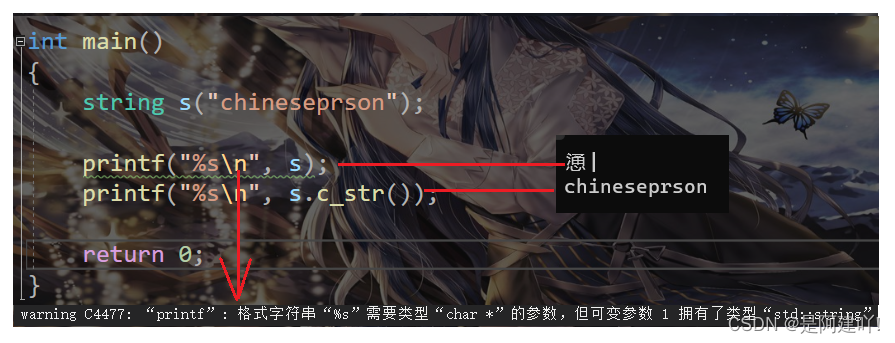
2.2.4.8 find 函数
size_t find (const string& str, size_t pos = 0) const;find 函数能够从第 pos 个位置开始从前往后查找包含 string 对象 str 的字符串的位置size_t find (const char* s, size_t pos = 0) const;find 函数能够从第 pos 个位置开始从前往后查找包含字符串 s 的位置size_t find (char c, size_t pos = 0) const;find 函数能够从第 pos 个位置开始从前往后查找包含字符 c 的位置find 函数若是能找到则返回包含需要查找内容第一个字符位置,否则返回 npos。#include <iostream>#include <string>using namespace std;int main(){string s("student test");string str("student");// 查找 str --> 找得到int pos = s.find(str, 0);cout << "str pos : " << pos << endl;// 查找字符串 --> 找得到pos = s.find("test" , 0);cout << "test pos : " << pos << endl;// 查找字符串 --> 找不到pos = s.find("Test", 0);cout << "Test pos : " << pos << endl;// 查找字符 --> 找得到pos = s.find('s', 0);cout << "s pos : " << pos << endl;// 查找字符 --> 找不到pos = s.find('a', 0);cout << "a pos : " << pos << endl;return 0;}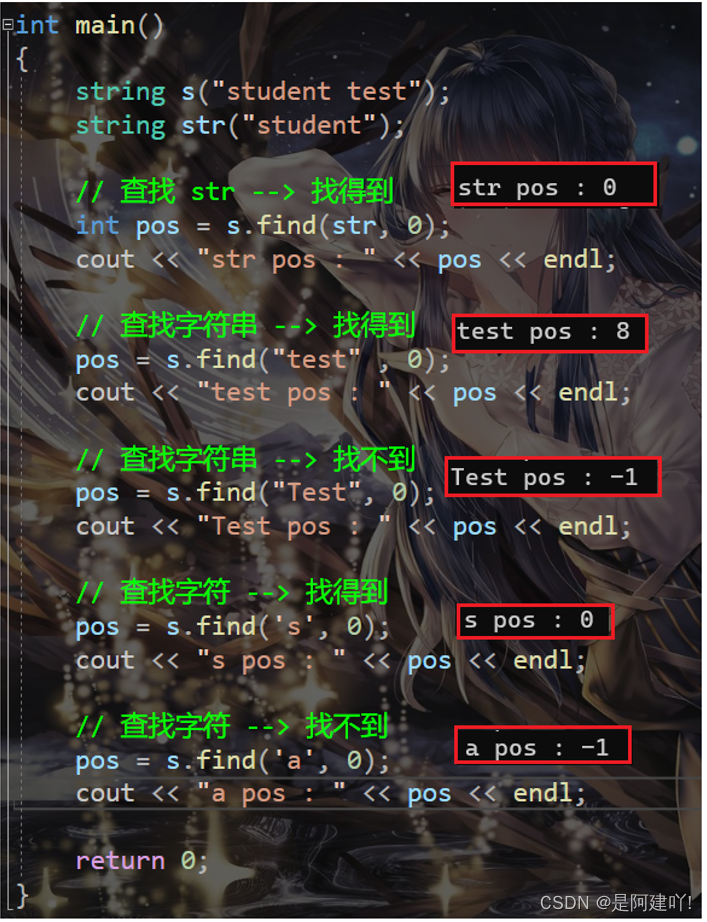
2.2.4.9 rfind 函数
size_t rfind (const string& str, size_t pos = npos) const;find 函数能够从第 pos 个位置开始从后往前查找包含 string 对象 str 的字符串的位置size_t rfind (const char* s, size_t pos = npos) const;find 函数能够从第 pos 个位置开始从前往后查找包含字符串 s 的位置size_t rfind (char c, size_t pos = npos) const;find 函数能够从第 pos 个位置开始从前往后查找包含字符 c 的位置#include <iostream>#include <string>using namespace std;int main(){string s("student test");string str("student");// 查找 str --> 找得到int pos = s.rfind(str, s.size()-1);cout << "str pos : " << pos << endl;// 查找字符串 --> 找得到pos = s.rfind("test", s.size() - 1);cout << "test pos : " << pos << endl;// 查找字符串 --> 找不到pos = s.rfind("test", s.size() - 5);cout << "test pos : " << pos << endl;// 查找字符串 --> 找不到pos = s.rfind("Test", s.size() - 1);cout << "Test pos : " << pos << endl;// 查找字符 --> 找得到pos = s.rfind('s', s.size() - 1);cout << "s pos : " << pos << endl;// 查找字符 --> 找不到pos = s.rfind('a', s.size() - 1);cout << "a pos : " << pos << endl;return 0;}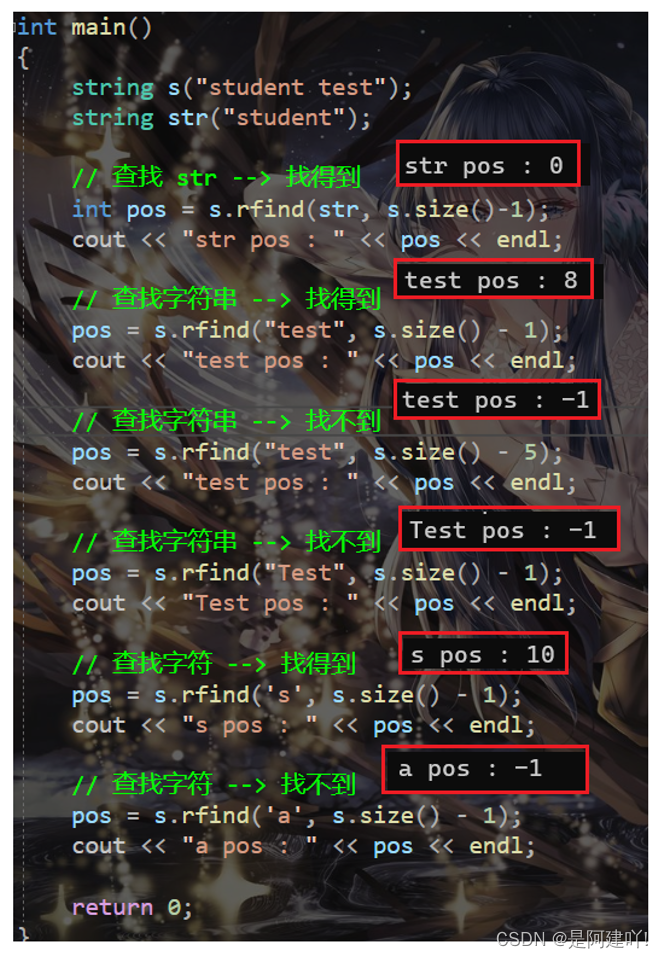
2.2.4.10 substr 函数
string substr (size_t pos = 0, size_t len = npos) const;在字符串中从第pos个位置开始截取len个字符返回#include <iostream>#include <string>using namespace std;int main(){string s("student test");// 在s中从第0个位置开始截取所有字符返回string ss = s.substr(0);cout << ss << endl;// 在s中从第3个位置开始截取3字符返回ss = s.substr(3,3);cout << ss << endl;return 0;}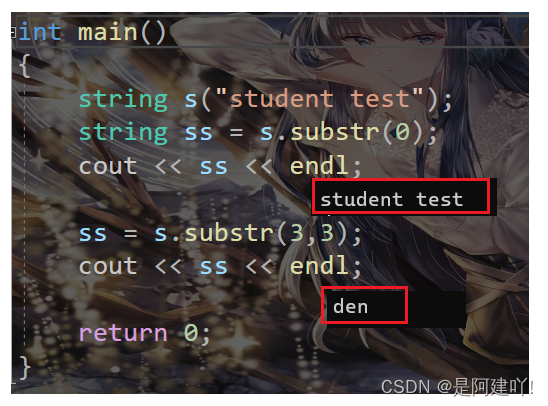
三、string拷贝问题
3.1 经典的string问题
上面已经对string进行了简单的介绍,大家只要能够正常使用即可。在面试中,面试官总喜欢让学生自己来模拟实现string,最主要是实现string的构造、拷贝构造、赋值运算符重载以及析构函数。大家看下以下string的实现是否有问题?
// 为了和标准库区分,此处使用Stringclass String{public: /*String():_str(new char[1]){*_str = '\0';}*///String(const char* str = "\0") 错误示范//String(const char* str = nullptr) 错误示范 String(const char* str = "") { // 构造String对象时,如果传递nullptr指针,可以认为程序非 if (nullptr == str) { assert(false); return; } _str = new char[strlen(str) + 1]; strcpy(_str, str); } ~String() { if (_str) { delete[] _str; _str = nullptr; } }private: char* _str;};// 测试void TestString(){ String s1("hello C++!!!"); String s2(s1);}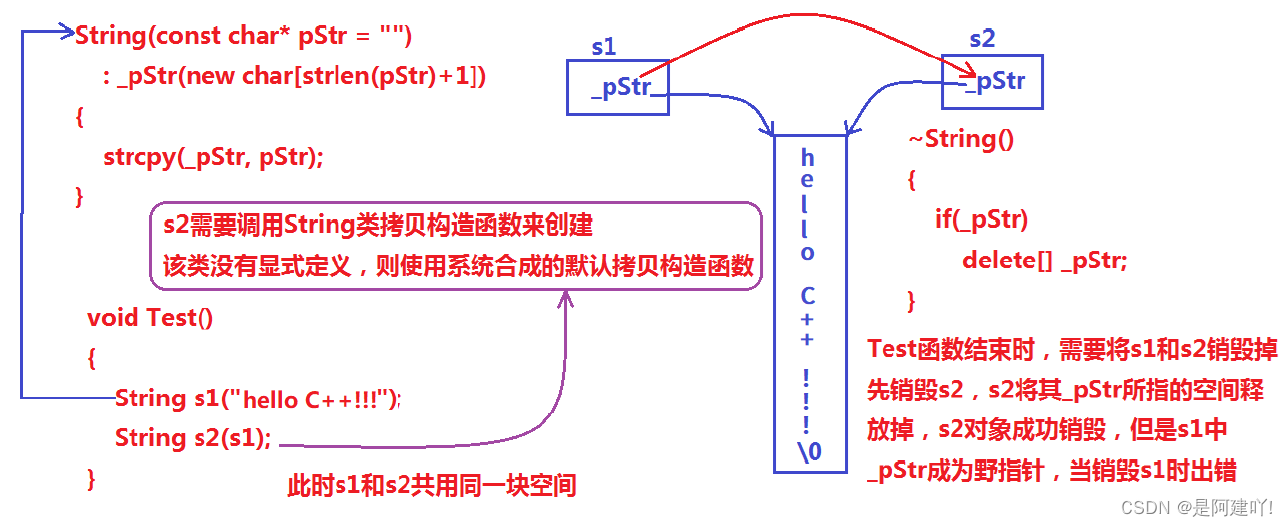
说明:上述String没有显式定义其拷贝构造函数与赋值运算符重载,此时编译器会合成默认的,当用s1构造s2时,编译器会调用默认的拷贝构造。最终导致的问题是,s1、s2共用同一块内存空间,在释放时同一块空间被释放多次而引起程序崩溃,这种拷贝方式,称为浅拷贝
3.2 浅拷贝
浅拷贝:也称位拷贝,编译器只是将对象中的值拷贝过来。如果对象中管理资源,最后就会导致多个对象共享同一份资源,当一个对象销毁时就会将该资源释放掉,而此时另一些对象不知道该资源已经被释放,以为还有效,所以当继续对资源进项操作时,就会发生发生了访问违规。
可以采用深拷贝解决浅拷贝问题,即:每个对象都有一份独立的资源,不要和其他对象共享。
3.3 深拷贝
如果一个类中涉及到资源的管理,其拷贝构造函数、赋值运算符重载以及析构函数必须要显式给出。一般情
况都是按照深拷贝方式提供。
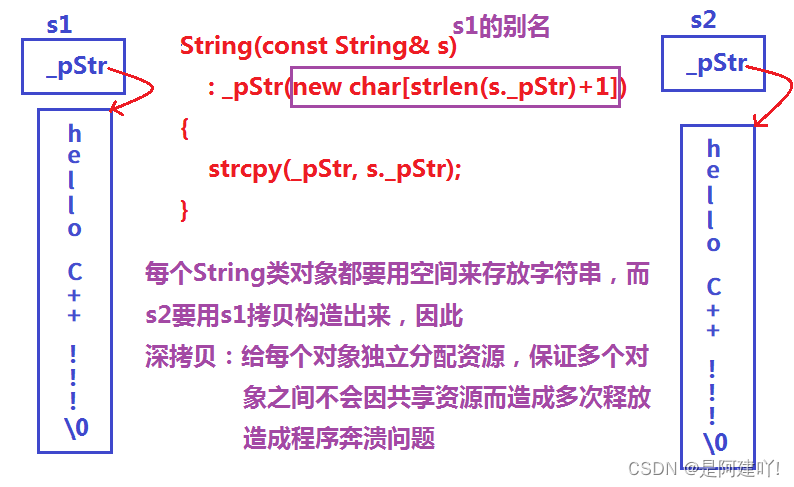
3.4 写时拷贝
写时拷贝就是一种拖延症,是在浅拷贝的基础之上增加了引用计数的方式来实现的。
引用计数:用来记录资源使用者的个数。在构造时,将资源的计数给成1,每增加一个对象使用该资源,就给计数增加1,当某个对象被销毁时,先给该计数减1,然后再检查是否需要释放资源,如果计数为1,说明该对象时资源的最后一个使用者,将该资源释放;否则就不能释放,因为还有其他对象在使用该资源。
四、string的模拟实现
4.1 string默认成员函数的实现
#include <iostream>#include <assert.h>using namespace std;namespace aj{ class string { public: // 这里缺省值给""的原因是空字符串本身就带一个'\0' // 而不是初始化的时候_str为nullptr // 初始化列表的顺序应该与声明相同 string(const char* str = "") :_capacity(strlen(str)) , _size(_capacity) { // 多开一个空间用来存放'\0' _str = new char[_capacity + 1]; strcpy(_str, str); }// 拷贝构造函数传统写法: /*string(const string& s) { _capacity = s._capacity; _str = new char[_capacity + 1]; _size = s._size; strcpy(_str, s._str); }*/// swap函数void swap(string& s) { std::swap(_str, s._str); std::swap(_capacity, s._capacity); std::swap(_size, s._size); } // 拷贝构造函数现代写法: // 构造一个使用s构造string对象tmp // tmp中的内容是this指向的对象所需要的 // 将两个对象的指针交换 // 即可达到我们的目的 string(const string& s) : _str(nullptr) , _capacity(0) , _size(0) { string tmp(s._str); swap(tmp); }// 赋值重载的传统写法:// 这里的传统写法与上面的拷贝构造的内容几乎相同// 而下面的现代写法复用了拷贝构造// 使得成员函数看起来更加简洁 // 赋值重载 传统写法 /*string& operator=(const string& s) { if (this != &s) { reserve(s._capacity); strcpy(_str, s._str); _capacity = s._capacity; _size = s._size; } return *this; }*/// 赋值重载的现代写法:// 首先判断是否是自己给自己赋值// 若是直接返回自己,否则进行下面的操作// 利用拷贝构造得来tmp// tmp中的数据是我们需要的数据// 而this指向的数据是我们需要改变的// tmp是临时变量,出了作用域会自动销毁// 我们将tmp的内容和this指向的内容交换// 实质上是两个指针的指向变化// 交换后this指向的内容就是我们需要的,返回// 而tmp中的内容是不需要的,出了作用域自动销毁 // 赋值重载 现代写法 /*string& operator=(const string& s) { if (this != &s) { string tmp(s); swap(tmp); } return *this; }*/// 拷贝构造函数的现代写法:// 这个现代写法与上面的本质相同// 这个是不判断是否是自己给自己赋值// 而是传值传参时利用拷贝构造直接得来tmp// 其他步骤相同// 赋值重载 现代写法 string& operator=(string tmp) { swap(tmp); return *this; }// 析构函数 ~string() { delete[] _str; _str = nullptr; _size = _capacity = 0; } private: char* _str; size_t _capacity; size_t _size; const static size_t npos; }; const size_t string::npos = -1;};4.2 string 中 c_str 、size 、capacity 和 empty 的实现
#include <iostream>#include <assert.h>using namespace std;#include <string>namespace aj{ class string { public: void clear() { _str[0] = '\0'; _size = 0; } const char* c_str()const { return _str; } size_t size()const { return _size; } size_t capacity() const { return _capacity; } bool empty()const { return _size == 0; } private: char* _str; size_t _capacity; size_t _size; const static size_t npos; }; const size_t string::npos = -1;};4.3 string 中 resize 和 reverse 的实现
#include <iostream>#include <assert.h>using namespace std;namespace aj{ class string { public: // 分三种情况 (n为新字符串的长度) // (1) n <= _size // (2) n > _size && n <= _capacity // (3) n > _capacity // 第一种情况为缩短,第二三种情况为增长, // 但第二种情况不需要扩容,第三种情况不需要 // 由于resize内部当传入的参数小于_capacity 时不会扩容 // 所以将第二三种情况放在一起 void resize(size_t n, char c = '\0') { if (n <= _size) { _str[n] = '\0'; _size = n; } else { reserve(n); _capacity = n; while (_size < n) { _str[_size] = c; _size++; } // 到这里 _size = n _str[_size] = '\0'; } } void reserve(size_t n) { if (n > _capacity) { // _capacity 记录的是需要存储有效数据的个数 // 所以我们这里要多开一个空间用来记录'\0' char* tmp = new char[n + 1]; strcpy(tmp, _str); delete[] _str; _str = tmp; _capacity = n; } } private: char* _str; size_t _capacity; size_t _size; const static size_t npos; }; const size_t string::npos = -1;};4.4 string 中 push_back 、append 和 operator+= 的实现
#include <iostream>#include <assert.h>using namespace std;namespace aj{ class string { public: void push_back(char c) { if (_size + 1 > _capacity) { // 这里不能盲目的开二倍,因为string可能是空字符串, // _capacity = 0 , 那么这里的二倍就没有意义,继续下面的操作会报错 reserve(_capacity == 0 ? 4 : 2 * _capacity); } _str[_size] = c; _size++; _str[_size] = '\0'; } void append(const char* str) { int len = strlen(str); if (_size + len > _capacity) { reserve(_size + len); } strcpy(_str + _size, str); _size += len; } string& operator+=(char c) { push_back(c); return *this; } void reserve(size_t n) { if (n > _capacity) { // _capacity 记录的是需要存储有效数据的个数 // 所以我们这里要多开一个空间用来记录'\0' char* tmp = new char[n + 1]; strcpy(tmp, _str); delete[] _str; _str = tmp; _capacity = n; } } private: char* _str; size_t _capacity; size_t _size; const static size_t npos; }; const size_t string::npos = -1;};4.5 string 中 operator[] 的实现
#include <iostream>#include <assert.h>using namespace std;namespace aj{ class string { public: char& operator[](size_t index) { return _str[index]; } const char& operator[](size_t index)const { return _str[index]; } private: char* _str; size_t _capacity; size_t _size; const static size_t npos; }; const size_t string::npos = -1;};4.6 string 中 迭代器 的实现
#include <iostream>#include <assert.h>using namespace std;namespace aj{ class string { public: typedef char* iterator; typedef const char* const_iterator; public: iterator begin() { return _str; } iterator end() { return _str + _size; } const_iterator begin() const { return _str; } const_iterator end() const { return _str + _size; } private: char* _str; size_t _capacity; size_t _size; const static size_t npos; }; const size_t string::npos = -1;};4.7 string 中 operator<< 和 operator>> 的实现
并不是所有的流插入、流提取都需要定义成友元函数,定义成友元函数的目的是为了访问成员的私有,这里不需要访问私有,则不需要定义成友元函数。
#include <iostream>#include <assert.h>using namespace std;namespace aj{ class string { private: char* _str; size_t _capacity; size_t _size; const static size_t npos; }; const size_t string::npos = -1; ostream& operator<<(ostream& _cout, const string& s) { for (auto ch : s) { cout << ch; } return _cout; }// 这个版本不好在,没有提前开空间// 即使开空间了,也不知道开多少// 大了浪费,小了又需要很多次扩容 //istream& operator>>(istream& _cin, string& s) //{ // // 流插入时需要将string中字符串清除 // s.clear(); // char ch = 0; // ch = _cin.get(); // while (ch != ' ' && ch != '\n') // { // s += ch; // ch = _cin.get(); // } // return _cin; //} istream& operator>>(istream& _cin, string& s) { // 流插入时需要将string中字符串清除 s.clear(); // 定义一个buff数组,作为缓冲 char buff[129] = { 0 }; char ch = 0; ch = _cin.get(); int i = 0; while (ch != ' ' && ch != '\n') { buff[i] = ch; ch = _cin.get(); if (i == 128) { s += buff; i = 0; } i++; } if (i != 0) { s += buff; } return _cin; }};4.8 string 中 比较函数 的实现
#include <iostream>#include <assert.h>using namespace std;namespace aj{ class string { public: bool operator<(const string& s) { return strcmp(_str, s._str) < 0; } bool operator<=(const string& s) { return *this == s || *this < s; } bool operator>(const string& s) { return !(*this <= s); } bool operator>=(const string& s) { return !(*this < s); } bool operator==(const string& s) { return strcmp(_str, s._str) == 0; } bool operator!=(const string& s) { return !(*this == s); } private: char* _str; size_t _capacity; size_t _size; const static size_t npos; }; const size_t string::npos = -1;};4.9 string 中 find 的实现
#include <iostream>#include <assert.h>using namespace std;namespace aj{ class string { public: // 返回c在string中第一次出现的位置 size_t find(char c, size_t pos = 0) const { assert(pos < _size); for (size_t i = pos; i < _size; i++) { if (_str[i] == c) { return i; } } return npos; } // 返回子串s在string中第一次出现的位置 size_t find(const char* s, size_t pos = 0) const { assert(pos < _size); char* ret = strstr(_str, s); if (ret == nullptr) { return npos; } return ret - _str; } private: char* _str; size_t _capacity; size_t _size; const static size_t npos; }; const size_t string::npos = -1;};4.10 string 中 insert 和 erase 的实现
#include <iostream>#include <assert.h>using namespace std;namespace aj{ class string { public: string& insert(size_t pos, char c) { assert(pos <= _size); if (_size + 1 > _capacity) { reserve(_capacity == 0 ? 4 : 2 * _capacity); } // 注意:无符号整形比较是用补码进行比较 // 当pos = 0,且 i = -1 时 , 0并不比-1大 // 记得将_size位置上的'\0'也向后移动 // 版本一 存在问题 /*for (size_t i = _size; pos <= i; i--) { _str[i + 1] = _str[i]; }*/ // 版本二 将pos转换为有符号整形进行比较 /*for (int i = _size; (int)pos <= i; i--) { _str[i + 1] = _str[i]; }*/ // 版本三 将 i 置为_size 的后面从后往前移动,防止了0与-1的比较 for (size_t i = _size + 1; pos < i; i--) { _str[i] = _str[i - 1]; } _str[pos] = c; _size++; return *this; } string& insert(size_t pos, const char* str) { assert(pos <= _size); int len = strlen(str); if (_size + len > _capacity) { reserve(_size + len); } for (size_t i = _size + len; pos < i; i--) { _str[i] = _str[i - len]; } strncpy(_str + pos, str, len); _size += len; return *this; } string& erase(size_t pos, size_t len = npos) { assert(pos < _size); if (len + pos > _capacity || len == npos) { _str[pos] = '\0'; _size = pos; } else { size_t begin = len + pos; while (begin <= _size) { _str[pos] = _str[begin]; pos++; begin++; } _size -= len; } return *this; } private: char* _str; size_t _capacity; size_t _size; const static size_t npos; }; const size_t string::npos = -1;};4.11 string 中 substr 的实现
#include <iostream>#include <assert.h>using namespace std;namespace aj{ class string { public: string substr(size_t pos = 0, size_t len = npos) const { assert(pos < _size); string tmp; int end = pos + len; if (pos + len > _size || len == npos) { len = _size - pos; end = _size; } // 提前开空间防止扩容 tmp.reserve(len); for (int i = pos; i < end; i++) { tmp += _str[i]; } return tmp; } private: char* _str; size_t _capacity; size_t _size; const static size_t npos; }; const size_t string::npos = -1;};4.12 string 实现汇总及函数测试
#pragma once#include <iostream>#include <assert.h>using namespace std;#include <string>namespace aj{ class string { // friend ostream& operator<<(ostream& _cout, const aj::string& s); // friend istream& operator>>(istream& _cin, aj::string& s); public: typedef char* iterator; typedef const char* const_iterator; public: // 这里缺省值给""的原因是空字符串本身就带一个'\0' // 而不是初始化的时候_str为nullptr // 初始化列表的顺序应该与声明相同 string(const char* str = "") :_capacity(strlen(str)) , _size(_capacity) { // 多开一个空间用来存放'\0' _str = new char[_capacity + 1]; strcpy(_str, str); }// 拷贝构造函数传统写法: /*string(const string& s) { _capacity = s._capacity; _str = new char[_capacity + 1]; _size = s._size; strcpy(_str, s._str); }*/// swap函数void swap(string& s) { std::swap(_str, s._str); std::swap(_capacity, s._capacity); std::swap(_size, s._size); } // 拷贝构造函数现代写法: string(const string& s) : _str(nullptr) , _capacity(0) , _size(0) { string tmp(s._str); swap(tmp); } // 赋值重载 传统写法 /*string& operator=(const string& s) { if (this != &s) { reserve(s._capacity); strcpy(_str, s._str); _capacity = s._capacity; _size = s._size; } return *this; }*/ // 赋值重载 现代写法 /*string& operator=(const string& s) { if (this != &s) { string tmp(s); swap(tmp); } return *this; }*/// 赋值重载 现代写法 string& operator=(string tmp) { swap(tmp); return *this; }// 析构函数 ~string() { delete[] _str; _str = nullptr; _size = _capacity = 0; } // // iterator iterator begin() { return _str; } iterator end() { return _str + _size; } const_iterator begin() const { return _str; } const_iterator end() const { return _str + _size; } / // modify void push_back(char c) { if (_size + 1 > _capacity) { // 这里不能盲目的开二倍,因为string可能是空字符串, // _capacity = 0 , 那么这里的二倍就没有意义,继续下面的操作会报错 reserve(_capacity == 0 ? 4 : 2 * _capacity); } _str[_size] = c; _size++; _str[_size] = '\0'; } string& operator+=(char c) { push_back(c); return *this; } // 分为两种情况 // (1) 追加后的字符串没有超过_capacity // (2) 追加后的字符串超过_capacity需要扩容 void append(const char* str) { int len = strlen(str); if (_size + len > _capacity) { reserve(_size + len); } strcpy(_str + _size, str); _size += len; } string& operator+=(const char* str) { append(str); return *this; } void clear() { _str[0] = '\0'; _size = 0; } void swap(string& s) { std::swap(_str, s._str); std::swap(_capacity, s._capacity); std::swap(_size, s._size); } const char* c_str()const { return _str; } / // capacity size_t size()const { return _size; } size_t capacity() const { return _capacity; } bool empty()const { return _size == 0; } // 分三种情况 (n为新字符串的长度) // (1)n <= _size // (2) n > _size && n <= _capacity // (3) n > _capacity // 第一种情况为缩短,第二三种情况为增长, // 但第二种情况不需要扩容,第三种情况不需要 // 由于reserve内部当传入的参数小于_capacity 时不会扩容 // 所以将第二三种情况放在一起 void resize(size_t n, char c = '\0') { if (n <= _size) { _str[n] = '\0'; _size = n; } else { reserve(n); _capacity = n; while (_size < n) { _str[_size] = c; _size++; } // 到这里 _size = n _str[_size] = '\0'; } } void reserve(size_t n) { if (n > _capacity) { // _capacity 记录的是需要存储有效数据的个数 // 所以我们这里要多开一个空间用来记录'\0' char* tmp = new char[n + 1]; strcpy(tmp, _str); delete[] _str; _str = tmp; _capacity = n; } } / // access char& operator[](size_t index) { return _str[index]; } const char& operator[](size_t index)const { return _str[index]; } / //relational operators bool operator<(const string& s) { return strcmp(_str, s._str) < 0; } bool operator<=(const string& s) { return *this == s || *this < s; } bool operator>(const string& s) { return !(*this <= s); } bool operator>=(const string& s) { return !(*this < s); } bool operator==(const string& s) { return strcmp(_str, s._str) == 0; } bool operator!=(const string& s) { return !(*this == s); } // 返回c在string中第一次出现的位置 size_t find(char c, size_t pos = 0) const { assert(pos < _size); for (size_t i = pos; i < _size; i++) { if (_str[i] == c) { return i; } } return npos; } // 返回子串s在string中第一次出现的位置 size_t find(const char* s, size_t pos = 0) const { assert(pos < _size); char* ret = strstr(_str, s); if (ret == nullptr) { return npos; } return ret - _str; } string substr(size_t pos = 0, size_t len = npos) const { assert(pos < _size); string tmp; int end = pos + len; if (pos + len > _size || len == npos) { len = _size - pos; end = _size; } // 提前开空间防止扩容 tmp.reserve(len); for (int i = pos; i < end; i++) { tmp += _str[i]; } return tmp; } string& insert(size_t pos, char c) { assert(pos <= _size); if (_size + 1 > _capacity) { reserve(_capacity == 0 ? 4 : 2 * _capacity); } // 注意:无符号整形比较是用补码进行比较 // 当pos = 0,且 i = -1 时 , 0并不比-1大 // 记得将_size位置上的'\0'也向后移动 // 版本一 存在问题 /*for (size_t i = _size; pos <= i; i--) { _str[i + 1] = _str[i]; }*/ // 版本二 将pos转换为有符号整形进行比较 /*for (int i = _size; (int)pos <= i; i--) { _str[i + 1] = _str[i]; }*/ // 版本三 将 i 置为_size 的后面从后往前移动,防止了0与-1的比较 for (size_t i = _size + 1; pos < i; i--) { _str[i] = _str[i - 1]; } _str[pos] = c; _size++; return *this; } string& insert(size_t pos, const char* str) { assert(pos <= _size); int len = strlen(str); if (_size + len > _capacity) { reserve(_size + len); } for (size_t i = _size + len; pos < i; i--) { _str[i] = _str[i - len]; } strncpy(_str + pos, str, len); _size+=len; return *this; } string& erase(size_t pos, size_t len = npos) { assert(pos < _size); if (len + pos > _capacity || len == npos) { _str[pos] = '\0'; _size = pos; } else { size_t begin = len + pos; while (begin <= _size) { _str[pos] = _str[begin]; pos++; begin++; } _size -= len; } return *this; } private: char* _str; size_t _capacity; size_t _size; const static size_t npos; }; const size_t string::npos = -1; ostream& operator<<(ostream& _cout, const string& s) { for (auto ch : s) { cout << ch; } return _cout; } //istream& operator>>(istream& _cin, string& s) //{ // // 流插入时需要将string中字符串清除 // s.clear(); // char ch = 0; // ch = _cin.get(); // while (ch != ' ' && ch != '\n') // { // s += ch; // ch = _cin.get(); // } // return _cin; //} istream& operator>>(istream& _cin, string& s) { // 流插入时需要将string中字符串清除 s.clear(); char buff[129] = { 0 }; char ch = 0; ch = _cin.get(); int i = 0; while (ch != ' ' && ch != '\n') { buff[i] = ch; ch = _cin.get(); if (i == 128) { s += buff; i = 0; } i++; } if (i != 0) { s += buff; } return _cin; } // 测试c_str size capacity resize empty void test_string1() { string s("chineseperson"); cout << s.c_str() << endl; cout << s.size() << endl; cout << s.capacity() << endl; cout << s.empty() << endl; cout << endl; s.resize(20, 'c'); cout << s.c_str() << endl; cout << s.size() << endl; cout << s.capacity() << endl; cout << endl; s.clear(); cout << s.c_str() << endl; cout << s.size() << endl; cout << s.capacity() << endl; cout << endl; string s1; cout << s1.c_str() << endl; cout << s1.size() << endl; cout << s1.capacity() << endl; cout << s1.empty() << endl; cout << endl; } // 测试 push_back append void test_string2() { string s("chineseperson"); s.push_back('6'); cout << s.c_str() << endl; cout << s.size() << endl; cout << s.capacity() << endl; cout << endl; s.append(" hellolllllllllll"); cout << s.c_str() << endl; cout << s.size() << endl; cout << s.capacity() << endl; cout << endl; string s1; s1.push_back('6'); cout << s1.c_str() << endl; cout << s1.size() << endl; cout << s1.capacity() << endl; cout << endl; } // 测试 += operator[] void test_string3() { string s("chineseperson"); s += '6'; cout << s.c_str() << endl; cout << s.size() << endl; cout << s.capacity() << endl; cout << endl; s += " hellolllllllllll"; cout << s.c_str() << endl; cout << s.size() << endl; cout << s.capacity() << endl; cout << endl; string s1; s1 += '6'; cout << s1.c_str() << endl; cout << s1.size() << endl; cout << s1.capacity() << endl; cout << endl; s1[0]++; cout << s1.c_str() << endl; cout << s1.size() << endl; cout << s1.capacity() << endl; cout << endl; } // 测试 迭代器 和 范围for void test_string4() { string s("chineseperson"); string::iterator it = s.begin(); while (it != s.end()) { cout << *it << ' '; it++; } cout << endl; for (auto ch : s) { cout <<ch << ' '; } } // 测试流插入流提取 void test_string5() { string s; cin >> s; cout << s << endl; } // 测试拷贝构造 , 赋值 void test_string6() { string s("chineseperson"); string s1(s); cout << s.c_str() << endl; cout << s.size() << endl; cout << s.capacity() << endl; cout << endl; cout << s1.c_str() << endl; cout << s1.size() << endl; cout << s1.capacity() << endl; cout << endl; string s2("hello"); cout << s2.c_str() << endl; cout << s2.size() << endl; cout << s2.capacity() << endl; cout << endl; s2 = s; cout << s.c_str() << endl; cout << s.size() << endl; cout << s.capacity() << endl; cout << endl; } // 测试string比较 void test_string7() { string s("chineseperson"); string s1(s); s1[0]++; cout << (s < s1) << endl; cout << (s <= s1) << endl; cout << (s > s1) << endl; cout << (s >= s1) << endl; cout << (s != s1) << endl; cout << (s == s1) << endl; } // 测试 find void test_string8() { string s("chineseperson"); cout << s.find('n') << endl; cout << s.find('n', 10) << endl; cout << s.find('a') << endl; cout << endl; cout << s.find("esepe") << endl; } // 测试insert erase void test_string9() { string s("chineseperson"); cout << s.c_str() << endl; cout << s.size() << endl; cout << s.capacity() << endl; cout << endl; s.insert(0, '6'); cout << s.c_str() << endl; cout << s.size() << endl; cout << s.capacity() << endl; cout << endl; s.insert(s.size(), '6'); cout << s.c_str() << endl; cout << s.size() << endl; cout << s.capacity() << endl; cout << endl; string s1(s); s.insert(0, "hello "); cout << s.c_str() << endl; cout << s.size() << endl; cout << s.capacity() << endl; cout << endl; s.insert(s.size(), " Yeah Yeah Yeah !!"); cout << s.c_str() << endl; cout << s.size() << endl; cout << s.capacity() << endl; cout << endl; string s2(s); cout << s2.c_str() << endl; cout << s2.size() << endl; cout << s2.capacity() << endl; cout << endl; s2.erase(0, 2); cout << s2.c_str() << endl; cout << s2.size() << endl; cout << s2.capacity() << endl; cout << endl; s2.erase(15); cout << s2.c_str() << endl; cout << s2.size() << endl; cout << s2.capacity() << endl; cout << endl; s2.erase(5); cout << s2.c_str() << endl; cout << s2.size() << endl; cout << s2.capacity() << endl; cout << endl; } // 测试 substr void test_string10() { string s("chineseperson"); cout << s.c_str() << endl; cout << s.size() << endl; cout << s.capacity() << endl; cout << endl; string s1 = s.substr(2, 5); cout << s1.c_str() << endl; cout << s1.size() << endl; cout << s1.capacity() << endl; cout << endl; string s2 = s.substr(2); cout << s2.c_str() << endl; cout << s2.size() << endl; cout << s2.capacity() << endl; cout << endl; string tmp("https://legacy.cplusplus.com/reference/string/string/substr/"); int i1 = tmp.find(':', 0); string ret1 = tmp.substr(0, i1); cout << ret1.c_str() << endl; int i2 = tmp.find('/', i1 + 3); string ret2 = tmp.substr(i1 + 3, i2); cout << ret2.c_str() << endl; string ret3 = tmp.substr(i2); cout << ret3.c_str() << endl; }};结尾
如果有什么建议和疑问,或是有什么错误,大家可以在评论区中提出。
希望大家以后也能和我一起进步!!??
如果这篇文章对你有用的话,希望大家给一个三连支持一下!!??